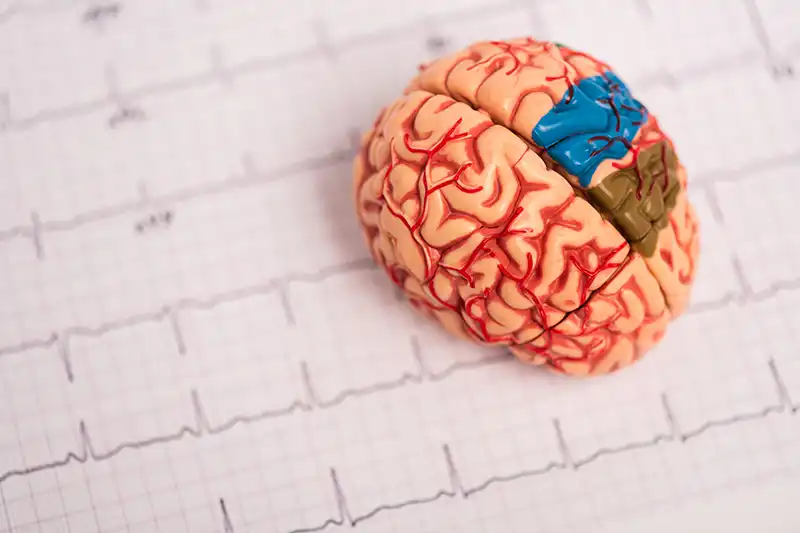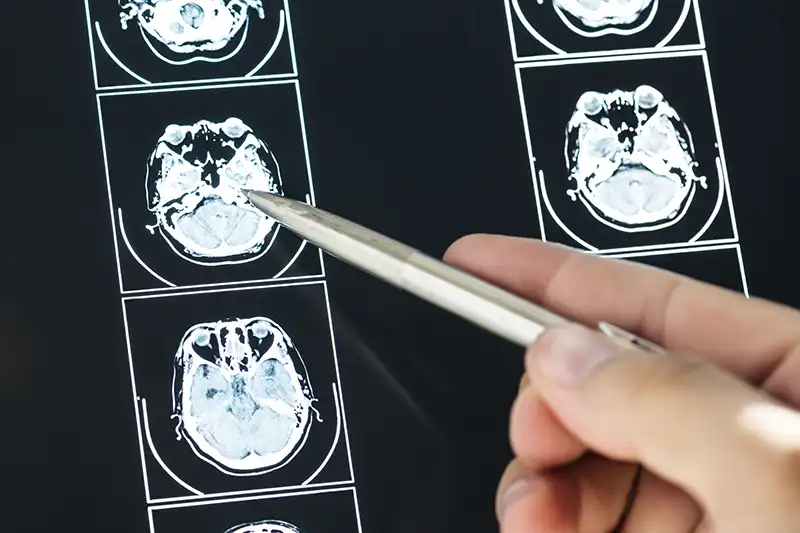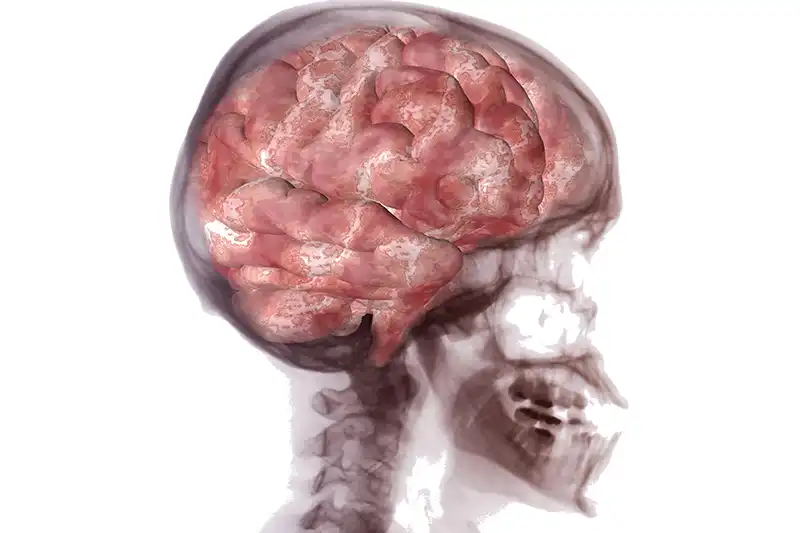Emergency Room for Stroke Care
A stroke is a medical emergency. Get help without the wait – no appointment needed.
If you suspect you or someone you know is having a stroke, visit the Surepoint ER near you for immediate medical attention. During a stroke, every second counts. Our doctors and nurses understand how important timely treatment is, so we are open 24/7 to provide stroke care. If you or someone you know experiences sudden trouble speaking and understanding language, numbness or paralysis in the face, arms, or legs, vision problems, or other stroke symptoms, seek medical attention immediately.

What Is A Stroke?
A stroke happens when blood flow to part of the brain is reduced or cut off, depriving the brain tissue of oxygen and nutrients. When the brain doesn’t get the oxygen and nutrients it needs, brain cells can deteriorate quickly, which can lead to brain damage, disability, or even death if the stroke is not treated fast enough.
There are two types of stroke. An ischemic stroke occurs when blood flow to the brain is restricted or blocked. This is the most common type of stroke, making up just under 90% of all strokes. The other 10% of strokes are called hemorrhagic strokes. This type of stroke happens when a blood vessel in the brain leaks or bursts, leading to bleeding in or around the brain.
Either type of stroke is a major medical emergency that requires swift treatment to minimize the damage to the brain. Recognizing symptoms early and getting treatment as soon as possible is vital. It could even be life saving.
Surepoint is Open 24/7 Near You!
If you think you or someone you know is experiencing a stroke, don’t wait! Get right to the Surepoint ER nearest you. We are open 24-7, no appointment needed.
What Causes a Stroke?
An ischemic stroke is caused when blood flow to the brain is somehow restricted or blocked. These restrictions or blockages are commonly caused by fatty deposits called plaque that build up on the walls of blood vessels (this is called “atherosclerosis”), or by blood clots.
Common risk factors for atherosclerosis that can lead to a stroke include high blood pressure, high cholesterol and triglycerides, and diabetes. Unhealthy diet, sedentary lifestyle, and smoking can cause or worsen these risk factors. If you have a family history of atherosclerosis or if you are a man over the age of 45 or a woman over the age of 55, you could be at increased risk.
Atherosclerosis is also one of the factors that can lead to blood clots that cause stroke. These clots can also form because of irregular heart beat, heart defects, infections that reach the bloodstream, and other blood clotting disorders. Blood clots can originate in the brain (this is called “thrombosis”), or they can travel to the brain from somewhere else in the body (this is called an “embolism”).
A hemorrhagic stroke occurs when a blood vessel in the brain ruptures or forms a leak. Risk factors for hemorrhagic stroke include uncontrolled high blood pressure, aneurysms, head trauma, weakness in blood vessel walls caused by protein deposits, brain tumors, overuse of blood-thinning medications, ischemic stroke that causes bleeding in the brain, and other conditions that weaken the blood vessels in the brain.
What Are the Signs and Symptoms of Stroke?

If you notice any of the following symptoms of stroke, you should get to the closest emergency medical facility right away.
The symptoms of stroke you should be aware of include:
- Sudden trouble with speaking and understanding what other people are saying
- Sudden numbness, weakness, or paralysis of the arms, legs, or face, often only affecting one side of the body
- A sudden, severe headache, sometimes accompanied by vomiting, dizziness, or loss of consciousness
- Sudden problems with vision in one or both eyes
- Sudden trouble walking, balancing, or coordinating movements
If you think someone you are with is having a stroke, remember the acronym F.A.S.T.
F.A.S.T stands for:
- Face – Is one side of the person’s face drooping or numb? Ask the person to smile. Is the person’s smile lopsided or uneven? If so, this is a sign of stroke.
- Arms – Is one arm weaker than the other? Ask the person to lift both arms. If one arm droops downward uncontrollably, this is a sign of stroke.
- Speech – Is the person’s speech slurred or otherwise strange? Ask the person to repeat a simple phrase. If they have sudden difficulty doing this, this is a sign of stroke.
- Time – If you notice any of these signs of stroke, call 911 immediately so medical personnel can administer life-saving treatment and get the person to the nearest emergency facility. If you cannot call 911 or if you are in an area where emergency personnel would be slow to arrive, get the person to the nearest emergency facility as fast as you can. Do not let them drive themselves. Note the time you noticed the symptoms. Every second counts when it comes to a stroke.
Should I Go To The ER If I Think I’ve Had a Stroke?
Yes. If you think you’ve had a stroke, or if you think someone you know has had a stroke, you should get to the closest emergency room for care immediately. The faster you can get to an emergency room, the faster you can be treated, and the more likely you will be to avoid permanent brain damage, disability, or death. Some of the most effective treatments for stroke must be administered within 3 hours of the first symptoms of a stroke, so again, the sooner you can get to an emergency room to be treated for a stroke, the better.
PLEASE NOTE: A person who is experiencing a stroke should not attempt to drive. It’s best to call 911.
Treating Stroke at Surepoint ER
If you think you or a friend or family member is having a stroke, the doctors and nurses at Surepoint ER are here to help. We’re experienced with many trauma and neurological services, including stroke, and we’re available 24/7 to provide you with stabilization and initial care. Our doctors will evaluate and assess your condition to determine whether you’re having a stroke, what type of stroke you are having, and what treatment is appropriate. Once treatment has begun, our emergency care team may wish to keep you overnight for observation or further care. We can also make arrangements to have you transferred to a local hospital if necessary – we’ll handle all the steps so you and your loved ones can focus on recovery.
Our Tips For Preventing Strokes

There are many healthy habits you can adopt that can reduce your chances of having a stroke. These are very similar to the habits you can adopt to help reduce your chances of heart attack or heart failure. They include:
- Maintaining a healthy weight
- Eating a healthy diet
- Exercising regularly
- Lowering your blood pressure
- Lowering your LDL cholesterol
- Drinking only in moderation or avoiding alcohol altogether
- Avoiding tobacco use
- Proper use of medications and treatment plans your doctor has prescribed to control heart disease, high cholesterol, high blood pressure, and diabetes
Don’t Miss the Signs: Recognize Stroke Symptoms and Act Fast!
Be safe and act fast: if you suspect that you or someone you know is having a stroke, get emergency medical attention now. Our emergency care staff is here 24/7 to get you the care you need at the moment you need it most. Click the link below to find the nearest Surepoint ER location. No appointment necessary.





